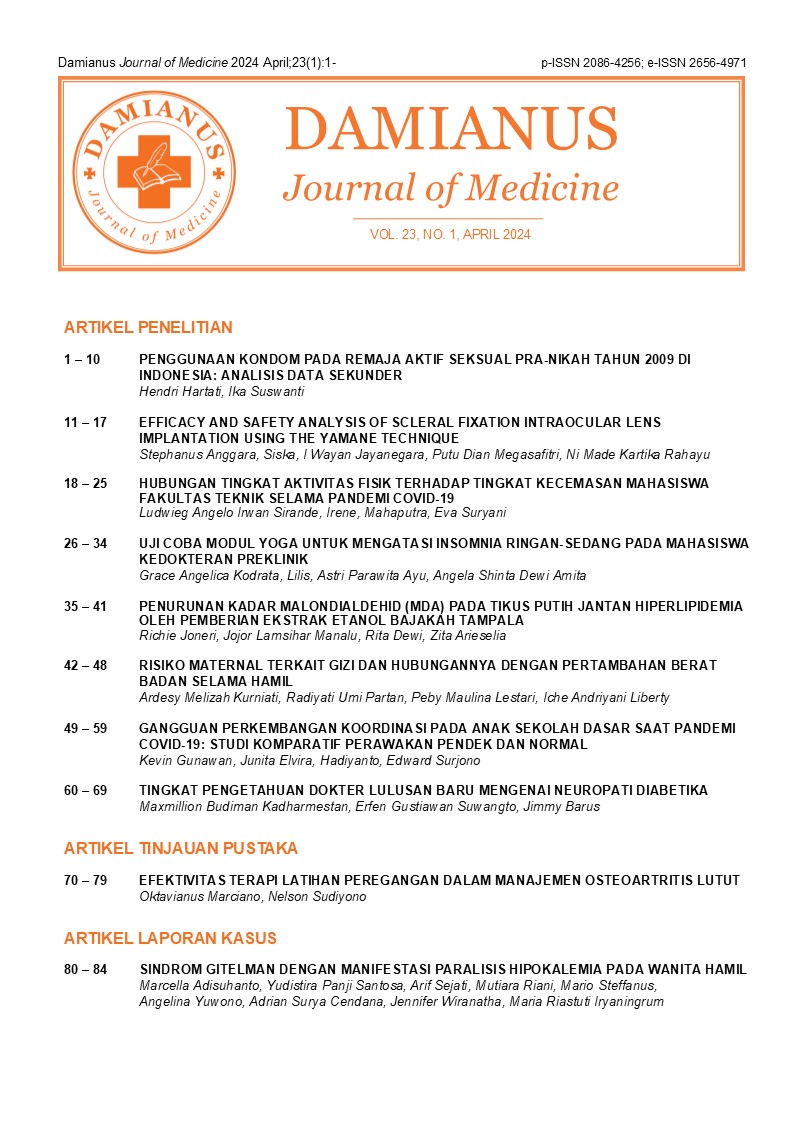Gangguan perkembangan koordinasi pada anak sekolah dasar saat pandemi COVID-19: Studi komparatif perawakan pendek dan normal
DOI:
https://doi.org/10.25170/djm.v23i1.3701Keywords:
gangguan perkembangan koordinasi, perawakan pendek, pandemi COVID-19, anak usia sekolah dasarAbstract
Pendahuluan: Gangguan perkembangan koordinasi (GPK) merupakan gangguan neurodevelopmental pada anak, berupa defisit keterampilan motorik kasar dan halus. Anak dengan perawakan pendek sering mengalami berbagai masalah neurodevelopmental. Di Indonesia, belum ada penelitian secara spesifik membahas atau mengetahui mengenai GPK pada anak perawakan pendek dan normal. Penelitian ini dilakukan untuk mengetahui gambaran GPK pada anak perawakan pendek dan perbandingannya dengan anak perawakan normal.
Metode: Penelitian potong lintang dilakukan pada 172 anak sekolah dasar usia 6 – 8 tahun di Kota Cirebon. Pengambilan sampel menggunakan metode consecutive sampling. Penilaian GPK dinilai berdasarkan kuesioner DCDQ 2007 dan DCDDaily-Q terjemahan Bahasa Indonesia. Uji statistik menggunakan IBM SPSS ver 22.
Hasil: Jumlah proporsi GPK berdasarkan kuesioner DCDQ 2007 dan DCDDaily-Q yaitu 11,0% (n=19). Kejadian GPK pada anak perawakan pendek ditemukan lebih banyak dibandingkan anak perawakan normal (14,1% vs 8,9%). Hasil uji analisis didapatkan adanya perbedaan yang bermakna antar kedua kelompok pada rerata mean skor variabel performa (p=0,040) dan pembelajaran aktivitas motorik (AM) (p=0,035) pada subjek penelitian dengan GPK.
Simpulan: GPK lebih banyak ditemukan pada anak dengan perawakan pendek, terutama dengan defisit variabel performa dan pembelajaran AM. Deteksi dini perkembangan motorik anak sangat diperlukan, terutama saat pandemi COVID-19.
Downloads
References
Blank R, Barnett AL, Cairney J, Green D, Kirby A, Polatajko H, Rosenblum S, Smits-Engelsman B, Sugden D, Wilson P, Vinçon S. International clinical practice recommendations on the definition, diagnosis, assessment, intervention, and psychosocial aspects of developmental coordination disorder. Dev Med Child Neurol. 2019 Mar;61(3):242-85.
Jenni KD. Gangguan perkembangan koordinasi: Skrining dan dampak terhadap status gizi, perilaku, dan prestsasi akademis pada anak usia sekolah. Sp-2 Ilmu Kesehatan Anak Jakarta. 2017.
Jessica SO. Anak dengan gangguan perkembang-an dan koordinasi: Dampak terhadap pencapaian akademis dan absensi. Program Pendidikan Dokter Umum S1 KKI Jakarta. 2018.
Cairney J, Veldhuizen S, Rodriguez MC, King-Dowling S, Kwan MY, Wade T, et al. Cohort profile: the Canadian coordination and activity tracking in children (CATCH) longitudinal cohort. BMJ Open. 2019 Sep 8;9(9):e029784.
Losse A, Henderson SE, Elliman D, Hall D, Knight E, Jongmans M. Clumsiness in children--do they grow out of it? A 10-year follow-up study. Dev Med Child Neurol. 1991 Jan;33(1):55-68
de Figueiredo CS, Sandre PC, Portugal LCL, Mázala-de-Oliveira T, da Silva Chagas L, Raony Í, et al. COVID-19 pandemic impact on children and adolescents' mental health: Biological, environmental, and social factors. Prog Neuropsychopharmacol Biol Psychiatry. 2021 Mar 2;106:110171.
Ni Ketut Aryastami, Endang Achadi. Can stunting be corrected?: Lessons from Indonesia, 26 June 2019, preprint (Version 1) available at Research Square [https://doi.org/10.21203/rs.2.10730/v1]
de Onis M, Branca F. Childhood stunting: a global perspective. Matern Child Nutr. 2016 May;12 Suppl 1(Suppl 1):12-26.
Bisi MC, Stagni R. Development of gait motor control: what happens after a sudden increase in height during adolescence? Biomed Eng Online. 2016 May 20;15(1):47.
Wilson BN, Crawford SG, Green D, Roberts G, Aylott A, Kaplan BJ. Psychometric properties of the revised Developmental Coordination Disorder Questionnaire. Phys Occup Ther Pediatr. 2009;29(2):182-202.
van der Linde BW, van Netten JJ, Otten BE, Postema K, Geuze RH, Schoemaker MM. Development and psychometric properties of the DCDDaily: a new test for clinical assessment of capacity in activities of daily living in children with developmental coordination disorder. Clin Rehabil. 2013 Sep;27(9):834-44.
National Center for Chronic Disease Prevention and Health Promotion (U.S.). Use and interpretation of the WHO and CDC Growth charts for children from birth to 20 years in the United States. Division of Nutrition, Physical Activity, & Obesity. 2013.
Wimbarti S, Siregar J, Oktaviana M, Regiastri R. Strengths and Difficulties Questionnaire Parent Report (SDQ-PR) as screening instrument of children mental health in Indonesia. J Psikol. 2019;46(2):130-44.
National Health and Nutrition Examination Survey (NHANES). Anthropometry Procedures Manual. 2016. [cited 2021 Jun 1]. Available: http://www.cdc.gov/nchs/nhanes/nhanes2015-2016/manuals15_16.htm.
Tenenbaum A, Shefer-Averbuch N, Lazar L, Yakobovitch-Gavan M, Phillip M, Oron T. Growth assessment of children during the COVID-19 pandemic-Can we rely on parental measurements? Acta Paediatr. 2021 Nov;110(11):3040-5.
Montes-Montes R, Delgado-Lobete L, Pereira J, Schoemaker MM, Santos-Del-Riego S, Pousada T. Identifying children with developmental coordination disorder via parental questionnaires. Spanish reference norms for the DCDDaily-Q-ES and correlation with the DCDQ-ES. Int J Environ Res Public Health. 2020 Jan 15;17(2):555.
Delgado-Lobete L, Santos-Del-Riego S, Pértega-Díaz S, Montes-Montes R. Prevalence of suspected developmental coordination disorder and associated factors in Spanish classrooms. Res Dev Disabil. 2019 Mar;86:31-40.
Delgado-Lobete L, Montes-Montes R, Pértega-Díaz S, Santos-Del-Riego S, Hartman E, Schoemaker MM. Motor performance and daily participation in children with and without probable developmental coordination disorder. Dev Med Child Neurol. 2022 Feb;64(2):220-7.
Jin H, Gu G, Qin Z, Bai D, Ma Y. A Population study of parenting and biological risk factors for children’s developmental coordination disorder. J Child Adolesc Behav. 2015;3:260.
Delgado-Lobete L, Montes-Montes R, Pértega-Díaz S, Santos-Del-Riego S, Cruz-Valiño JM, Schoemaker MM. Interrelation of individual, country and activity constraints in motor activities of daily living among typically developing children: A cross-sectional comparison of Spanish and Dutch populations. Int J Environ Res Public Health. 2020 Mar 5;17(5):1705.
Du W, Ke L, Wang Y, Hua J, Duan W, Barnett AL. The prenatal, postnatal, neonatal, and family environmental risk factors for Developmental Coordination Disorder: A study with a national representative sample. Res Dev Disabil. 2020 Sep;104:103699.
Casale D, Desmond C. Recovery from stunting and cognitive outcomes in young children: evidence from the South African Birth to Twenty Cohort Study. J Dev Orig Health Dis. 2016 Apr;7(2):163-71.
Leroy JL, Frongillo EA, Dewan P, Black MM, Waterland RA. Can children catch up from the consequences of undernourishment? Evidence from child linear growth, developmental epigenetics, and brain and neurocognitive development. Adv Nutr. 2020 Jul 1;11(4):1032-41.
Kashiwagi M, Tamai H. Brain mapping of developmental coordination disorder. In: Signorelli F, editor. Functional brain mapping and the endeavor to understand the working brain. InTech. 2013.
Semba RD, de Pee S, Sun K, Sari M, Akhter N, Bloem MW. Effect of parental formal education on risk of child stunting in Indonesia and Bangladesh: a cross-sectional study. Lancet. 2008 Jan 26;371(9609):322-8.
Van der Linde BW, van Netten JJ, Otten B, Postema K, Geuze RH, Schoemaker MM. Activities of daily living in children with developmental coordination disorder: Performance, learning, and participation. Phys Ther. 2015 Nov;95(11):1496-506.
Wilson P, Ruddock S, Rahimi-Golkhandan S, Piek J, Sugden D, Green D, Steenbergen B. Cognitive and motor function in developmental coordination disorder. Dev Med Child Neurol. 2020 Nov;62(11):1317-1323.
Handryastuti S, Pusponegoro HD, Nurdadi S, Chandra A, Pramita FA, Soebadi A, et al. Comparison of cognitive function in children with stunting and children with undernutrition with normal stature. J Nutr Metab. 2022 Jul 12;2022:9775727.
Crookston BT, Penny ME, Alder SC, Dickerson TT, Merrill RM, Stanford JB, et al. Children who recover from early stunting and children who are not stunted demonstrate similar levels of cognition. J Nutr. 2010 Nov;140(11):1996-2001.
Demers I, Moffet H, Hébert L, Maltais DB. Growth and muscle strength development in children with developmental coordination disorder. Dev Med Child Neurol. 2020 Sep;62(9):1082-8.
Downloads
Published
Issue
Section
License
Copyright (c) 2024 Damianus Journal of Medicine

This work is licensed under a Creative Commons Attribution-ShareAlike 4.0 International License.














